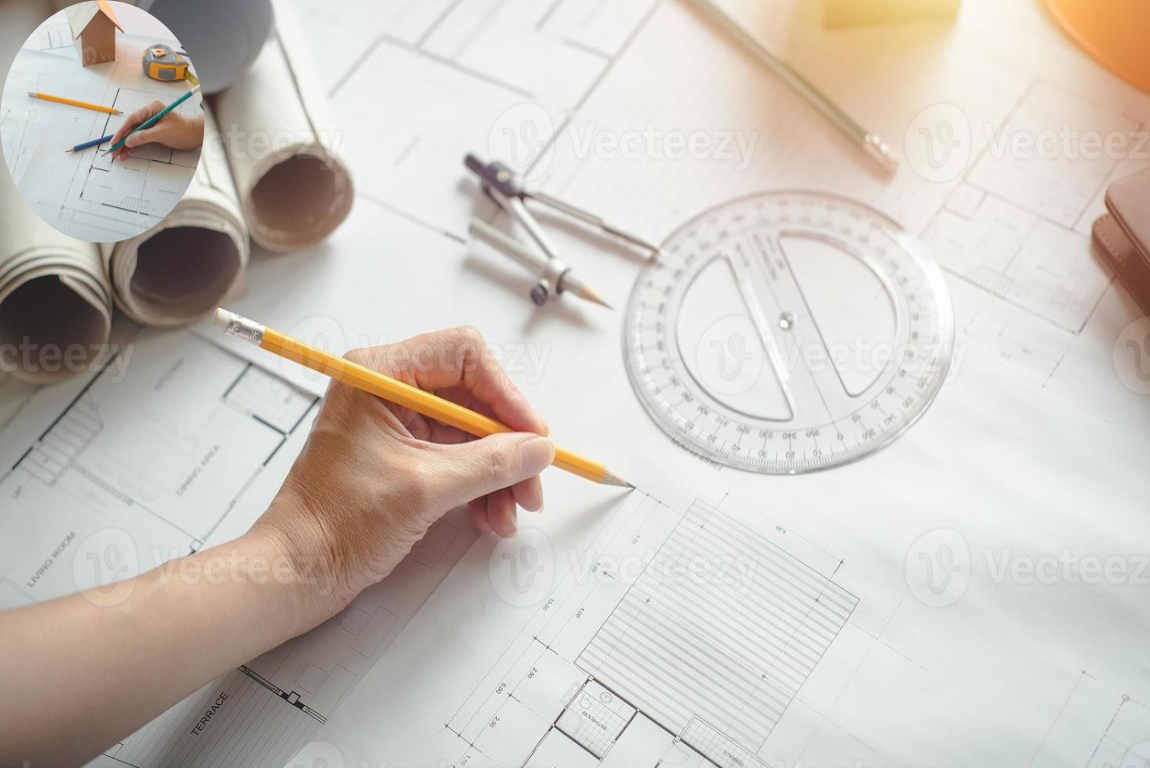Architecture is a fascinating blend of art and science. It requires creativity to design beautiful structures while also demanding technical expertise to ensure those designs are safe and functional. One of the most critical elements in achieving this balance is mathematics. The question arises: what math is used in house architecture? Understanding this intersection can enhance our appreciation of the architectural marvels around us and the meticulous planning that goes into creating them.
Mathematics is integral to every stage of architectural design and construction, from initial sketches to final blueprints. It ensures that buildings are not only visually appealing but also structurally sound.We will delve into key mathematical disciplines, practical applications, and modern technologies and even examine iconic examples to illustrate how math shapes the homes we live in.
Understanding the Connection Between Math and Architecture

When we think of architecture, we often envision stunning buildings and elaborate designs. However, behind each architectural masterpiece lies a foundation of mathematical principles. These principles guide architects in their quest to create structures that are not only beautiful but also durable and functional.
The Dual Role of Math
Mathematics serves a dual role in architecture. Firstly, it ensures structural integrity. Architects must calculate load distributions, material strengths, and safety factors to prevent structural failures. Secondly, math enhances aesthetic appeal. Concepts such as symmetry, proportion, and balance are rooted in mathematical principles, enabling architects to create visually appealing designs.
Architectural Marvels Shaped by Math
Throughout history, many architectural wonders have been designed using mathematical concepts. For instance:
- The Parthenon in Greece showcases the Golden Ratio, a mathematical principle that creates visually harmonious proportions.
- The Guggenheim Museum in New York City uses a spiral design, illustrating how geometric shapes can influence architectural creativity.
These examples illustrate the profound connection between math and architecture, laying a foundation for both structural functionality and aesthetic beauty.
Importance of Math in Planning and Building Homes
During the planning and building stages of home construction, mathematics becomes indispensable. It helps architects and builders:
- Create accurate blueprints to guide construction.
- Estimate costs and material requirements.
- Ensure that homes meet building codes and regulations.
Understanding the connection between math and architecture is essential for anyone interested in creating or inhabiting a home.
Key Mathematical Disciplines Used in House Architecture

Mathematics in architecture can be categorized into several key disciplines, each playing a significant role in the design and construction process. Let’s explore these mathematical branches more closely.
Geometry
Geometry is the most recognized branch of mathematics in architecture. It is crucial for defining shapes, spatial forms, and symmetry in designs.
- Shapes for Stability and Design: Architects often use fundamental geometric shapes such as triangles and circles. Triangles provide stability, making them a preferred choice for roof structures.
- The Golden Ratio: This mathematical concept is prevalent in architecture, promoting aesthetically pleasing proportions. The Golden Ratio can be seen in many famous structures, ensuring harmony between various design elements.
- Fractals: These complex geometric patterns are used to create intricate designs that mimic natural forms, adding an organic touch to architectural projects.
You may also read (exploring the role of trusses in modern house design).
Algebra
Algebra plays a vital role in various calculations and estimations needed in architecture.
- Load Calculations: Architects use algebraic equations to calculate loads, areas, and volumes. This ensures that structures can support the weight they are designed to bear.
- Budgeting: Algebra is also essential for estimating project costs. By using formulas, architects can accurately predict expenses related to materials and labor, enabling better financial planning.
- Scaling Models: Algebraic formulas help architects create scale models, allowing them to visualize designs before construction begins.
Trigonometry
Trigonometry is another essential branch of mathematics used extensively in architecture.
- Calculating Angles: Architects utilize trigonometric functions to determine angles and slopes, which are crucial for designing roofs and complex forms.
- Structural Forces: Understanding how forces act on a structure—whether from wind, weight, or other factors—requires knowledge of trigonometry to ensure safety and stability.
Calculus and Physics
While they may not be as visibly prominent, calculus and physics play a significant role in the field of architecture.
- Dynamic Load Analysis: Calculus is used in structural engineering to analyze how loads change over time, ensuring that buildings can withstand various stresses and strains.
- Optimizing Materials: Through calculus, architects can determine the most effective materials to use, ensuring safety while minimizing costs.
Summary of Interrelation
These mathematical disciplines do not function in isolation. Instead, they interrelate, creating a comprehensive framework for architectural design. For example, geometry informs algebraic calculations for areas, while trigonometry aids in understanding angles necessary for geometric shapes. This interconnectedness underscores the importance of mathematics in creating functional and aesthetically pleasing spaces.
Practical Applications of Math in Home Architecture

The applications of mathematics in home architecture extend beyond theoretical concepts. Here are some practical ways in which math influences various aspects of architectural design.
Structural Integrity and Safety
One of the primary concerns in architecture is ensuring structural integrity and safety. Mathematical calculations play a crucial role in this regard.
You may also read (masterinz home kitchen outlet placement what you need to know).
- Load-Bearing Calculations: Architects must calculate how weight is distributed throughout a structure to ensure its stability. This involves understanding how different materials and shapes can effectively bear loads.
- Material Strength: Selecting the right materials often relies on mathematical models that predict their performance under stress.
- Finite Element Analysis: This engineering tool utilizes mathematical computations to simulate physical conditions, enabling architects to design safer and more resilient buildings.
Design and Aesthetic Considerations
While safety is paramount, aesthetics cannot be overlooked. Mathematics plays a crucial role in achieving a harmonious design.
- Symmetry and Proportion: Math helps architects create symmetrical designs that are visually appealing. Using mathematical sequences, such as the Fibonacci sequence, can help guide the proportions of different elements.
- 2D and 3D Modeling: Modern architects utilize mathematical models to visualize their designs in both two dimensions and three dimensions, enabling more effective planning and adjustments.
Space Optimization and Functionality
Mathematics plays a crucial role in maximizing space efficiency within homes.
- Calculating Area and Volume: Architects use math to determine the best layouts for rooms, ensuring that spaces are both functional and comfortable.
- Ergonomics: Understanding human factors in design involves mathematical principles to create spaces that enhance usability and comfort.
- Natural Light and Ventilation: Mathematical planning ensures that homes are designed to optimize natural light and airflow, enhancing energy efficiency.
Cost Estimation and Project Feasibility
Mathematics is also vital for budgeting and determining project feasibility.
- Budget Planning: Algebraic and statistical methods are employed to create detailed budget plans, ensuring projects remain financially viable.
- Predicting Material Quantities: Accurate calculations enable architects to estimate the precise amount of materials needed, thereby reducing waste and lowering costs.
Summary of Practical Applications
These practical applications underscore the multifaceted role of mathematics in architecture, ensuring that homes are not only aesthetically pleasing but also safe, functional, and cost-effective.
Modern Tools and Technologies Integrating Math in Architecture

Advancements in technology have revolutionized the way mathematics is used in architecture. Here are some modern tools and technologies that integrate math into architectural practices.
Computer-Aided Design (CAD)
CAD software has become an essential tool for architects. It enables the precise creation of designs by incorporating mathematical calculations directly into the design process. With CAD, architects can visualize intricate details and make adjustments quickly and easily.
Building Information Modeling (BIM)
BIM represents a significant leap forward in architectural design. It integrates various aspects of a building into a single model, enabling architects to perform complex mathematical analyses related to structural integrity, cost, and other factors.
Parametric Design
Parametric design utilizes algorithms to create adaptable architectural forms. This approach enables architects to experiment with various design parameters, yielding innovative structures that are both functional and aesthetically pleasing.
Mathematical Modeling Software
Various mathematical modeling software tools enable architects to perform advanced calculations and simulations. These tools enhance precision and innovation, allowing the creation of more complex designs that push the boundaries of traditional architecture.
Case Studies: Math in Iconic Home Architecture
Examining iconic architectural examples can shed light on how math shapes home design. Here are three notable case studies.
Greek Architecture
The Parthenon in Greece is a prime example of how geometry and proportion influence architecture. Its design incorporates the Golden Ratio, ensuring that its proportions are visually harmonious. This ancient structure remains a testament to the power of math in creating timeless beauty.
Modern Sustainable Homes
Many contemporary sustainable homes utilize mathematical modeling to optimize energy efficiency. For instance, homes designed with passive solar principles often require complex calculations to determine the optimal orientation and layout for maximizing natural light and minimizing energy consumption.
Fractals and Parametric Equations
The Heydar Aliyev Center in Azerbaijan showcases innovative design through the use of fractals and parametric equations. Its unique, flowing forms demonstrate how mathematics can lead to groundbreaking architectural designs that challenge conventional aesthetics.
Lessons Learned
These case studies illustrate the critical role of mathematics in home architecture. Understanding these principles can enrich our appreciation for the structures we inhabit and the creativity that goes into their design.
You may also read (how to use a printer for house blueprint projects).
